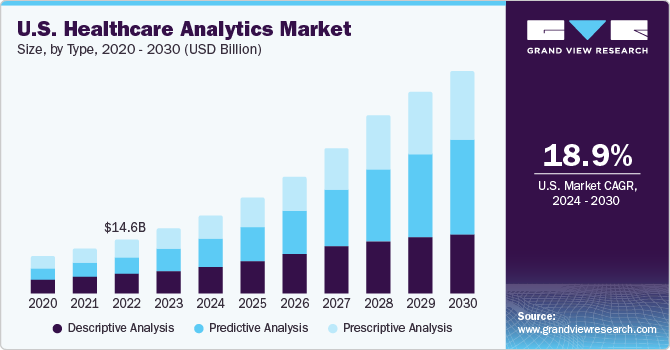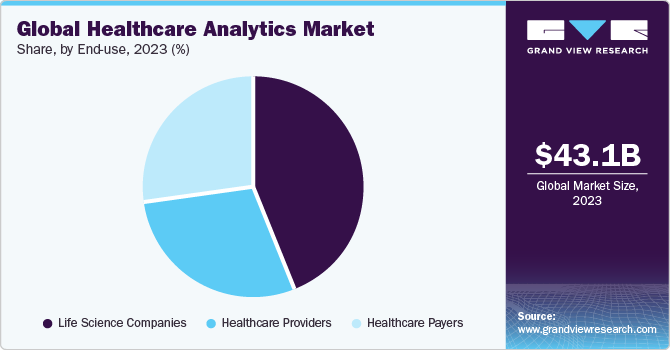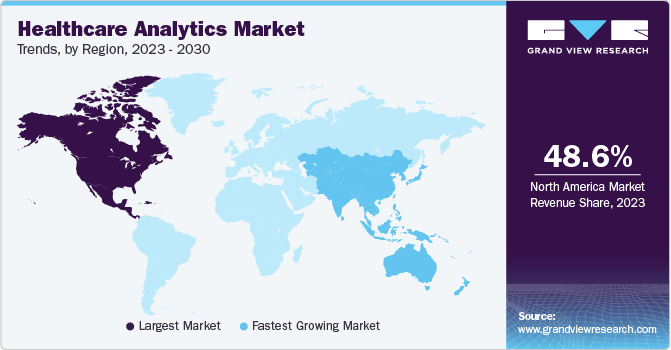- Home
- »
- Healthcare IT
- »
-
Healthcare Analytics Market Size, Share, Trends Report 2030GVR Report cover
![Healthcare Analytics Market Size, Share & Trends Report]()
Healthcare Analytics Market Size, Share & Trends Analysis Report By Type (Descriptive Analysis, Predictive Analysis), By Component (Software, Hardware), By Delivery Mode, By Application, By End-use, By Region, And Segment Forecasts, 2024 - 2030
- Report ID: 978-1-68038-937-1
- Number of Report Pages: 150
- Format: PDF, Horizon Databook
- Historical Range: 2018 - 2022
- Forecast Period: 2024 - 2030
- Industry: Healthcare
Healthcare Analytics Market Size & Trends
The global healthcare analytics market size was valued at USD 43.1 billion in 2023 and is expected to expand at a compound annual growth rate (CAGR) of 21.1% from 2024 to 2030. The healthcare industry faces challenging issues such as the lack of better patient care, skyrocketing costs of treatment, and less patient retention & engagement. As a result, healthcare analytics are being incorporated into every aspect of the industry to give better care to patients and for better industry operations. These factors are key reasons for the growth of the healthcare analytics industry.

COVID-19 saw significant growth in the industry due to an increase in the need for digital solutions and better analytics tools to manage patient load in the healthcare industry. The amount of clinical data generated during the pandemic needed proper management. With the help of analytics tools and platforms, researchers and professionals derive better outcomes, predict trends, and understand the dynamics of disease outbreaks much better. An increasing burden on health establishments and professionals has created a need to adopt healthcare analytics platforms for better management and delivery of better care to patients.
In June 2020, NIH launched a healthcare data analytics platform to collect patient data for actionable insights on COVID-19. However, the post-pandemic effect shows healthcare analytics as a part of a larger solution that has much wider implications for understanding clinical data for healthcare professionals. In May 2021, the WHO and a German federal agency established a hub for pandemic data for analyzing the spread of disease, innovation in the field of medicine, and surveillance of patients to mitigate further risks in the future.
Market Dynamics
A rapid rate of technological advancements and massive investments by the healthcare industry into IT development and digitization have been key factors for the monumental growth of the healthcare analytics industry. In January 2021, Optum, Inc. collaborated with Change Healthcare to advance the technology-enabled healthcare platform. Both companies provide their consumers with data analytics solutions, software, and a technology-advanced healthcare platform. Analytical platforms that are currently being deployed by healthcare institutions across the globe help in patient management, their retention, due to which better care can be delivered. Deployment of healthcare analytical platforms not only increases the productivity of staff, but overall patient management has been improved and the burden on caregivers has been minimized.
Healthcare analytics can be deployed for various functions in an establishment, for management of grants and donations given to the hospital, patient records, making appointments, insurance claims, etc. It can improve the quality of care delivered to patients and give insights for managing overall business establishments, better patient outreach, management of the spread of diseases, etc. Grainger College of Engineering, Illinois, developed the Health Data Analytics Initiative as a hub connecting clinical investigators, engineers, AI experts, and data scientists, which helps deliver better solutions by improving research quality via deploying AI platforms and analytical tools.
Government initiatives and a massive flux of money in the healthcare industry also drive innovation. They are responsible for the increasing adoption of such analytical platforms by healthcare establishments. Analytical platforms are used by hospitals and other establishments for managing and interpreting clinical data from various studies conducted, studying historical data and analyzing it to establish trends, and developing methods, tools, and technologies to get optimal results.
Policymakers are also deploying these analytics platforms to study statistics and models for making better decisions and policies regarding healthcare establishments and delivering care to patients. The U.S. government has been taking initiatives in this direction; the HealthData.gov portal has information from several federal databases on topics such as community health performance, clinical data, and medical and scientific knowledge for developers, which is accessible by an application programming interface.
Type Insights
Descriptive analysis held the largest market share of 35.4% in 2023. Descriptive analytics has been widely used during the pandemic to study historical data and patient histories to study the spread of the virus, which has been a key factor driving growth in this segment. Descriptive analytics has proved to be a valuable tool for understanding what happened by accessing historical data and turning it into actionable insights. In addition, hospitals are using it to monitor the performance of insurance claims by detecting irregularities and errors in the claims. Many organizations are using descriptive analysis tools to increase market growth potential.
Predictive analysis is the fastest-growing analytics type segment since it uses data sets created by descriptive analytics to analyze data for actionable future insights. More and more companies are adopting analytics for better growth prospects, which has been a key propellant for the growth of this segment. It has become necessary to adopt these platforms to predict future trends in the market for the company to take appropriate measures that foster the overall growth of this segment.
Component Insights
The services segment dominated the market with a share of 37.7% in 2023. The healthcare industry has been investing a substantial amount of capital in the IT industry to develop platforms and digitize data for analytics. A majority of companies need a data analytics component, so they are outsourcing the data analytics aspect of their IT. This has resulted in the growth of data analytics companies offering a complete set of services to companies. An increase in services offered by data analytics companies has been responsible for segment growth.
The services segment is anticipated to register the fastest growth rate of 21.8% due to an increase in patient load in the health industry and a rise in disease prevalence, which has resulted in massive amounts of clinical data generated, insurmountable pressure on the industry to give better care, better results and cost-effective treatments to patients is further propelling this market towards growth. The need to adopt analytical methods and tools for better patient monitoring and delivering better treatments are key factors for the growth of this segment.
End-use Insights
Life science companies dominated the market with a revenue share of 44.3% in 2023. Currently, the largest users of analytical tools and platforms are life-science companies for reducing their product costs, increasing profit margins, producing better products, and driving faster adoption and growth in the segment. Companies constantly invest in improving their product portfolios and offerings to cater to a wider population. This gives rise to a need for analytical tools to better understand and predict the market and drive value-based decisions.

Healthcare providers are anticipated to register the fastest growth rate of 25.8% through 2030, as during the pandemic, and even after that, the burden of delivering cost-effective care and better patient management has been tremendous on hospitals and healthcare professionals, which has resulted in the growth of this segment. The need to manage patient records, disease surveillance, and deliver cost-effective care to patients have been key factors for the wider adoption of healthcare analytics and are foreseen to propel segment growth.
Delivery Mode Insights
The on-premises segment dominated the market with a revenue share of 47.8% in 2023. Most institutions are currently installing software and tools to store data at their premises due to the ease of access and security, resulting in a large market share of this type of delivery. Current systems in small organizations are practical, but when scaled up, it can take time and effort to manage data if an organization is dealing with a large dataset. This can mean large capital investment in data storage and security.
The cloud-based segment is projected to grow at the fastest growth rate of 24.4% due to ease of storage, less capital investment, and increased flexibility and efficiency; these factors also add up to continuous growth in this delivery mode. Cloud-based storage can also be on-premises, but issue of scalability comes into picture, even though public cloud storage solutions are a key factor for the growth of cloud-based storage solutions becoming the fastest growing sub-segment, limitations of same include less privacy, and more security concerns regarding loss of data.
Application Insights
Financial applications held the largest market share of 36.3% in 2023. Healthcare institutions and organizations are continually striving to minimize cost of treatment yet deliver better care to patients, attributed to the growth of this segment. The financial segment is anticipated to grow at the fastest rate over the forecast period. Thus, companies perform better by reducing costs and preventing fraud.
Healthcare institutions incur costs in the form of insurance claims, which can also be fraudulent. To mitigate such risks and minimize such occurrences, healthcare organizations deploy analytical tools for predictive and descriptive analysis to deliver better care to patients, reduce overall costs of operations, and minimize fraud in insurance claims. The need to perform financially well has been a key driver for adopting this application type.
Regional Insights
North America dominated the market in 2023 with a revenue share of 48.6%. The region has state-of-the-art healthcare facilities, and the adoption of these platforms and better technological availability have all resulted in a large market share for North America. The rising burden of chronic ailments and an increasing geriatric population have also created a need for hospitals and other organizations to adopt analytics tools. In addition, the presence of key players has also been a factor in the large market revenue share. In March 2022, Microsoft launched Microsoft Cloud for Healthcare, a collaboration between patients and providers to help deliver better insights related to patient care.

Asia Pacific is anticipated to register the fastest growth rate of 22.9%. Fast development, more spending capacity, and a growing population have all resulted in the fast growth registered by APAC. There have been significant growth and advancements in industry in this region, which has also contributed to its growth. The reliance of consumers and healthcare providers on IT has been increasing; thus, the adoption rates of the analytics sector have also gone up. Australia-based start-up for healthcare analytics Prospection has opened an office in Japan and will collaborate with international pharma customers to develop new treatments for the Japanese population.
Key Companies & Market Share Insights
Key industry players are adopting different strategies, constantly innovating and bringing up new technologies to understand better data derived from patient information, understand the spread and containment of disease, to deliver better care solutions to healthcare providers and institutions. Using big data analytics and AI has also given rise to new platforms to better understand and analyze data. Swedish Health Services, a U.S.-based healthcare organization, has developed a platform for healthcare workers to report real-time data on COVID-19 patient volumes and other parameters to track the status of facilities across hospitals.
Key Healthcare Analytics Companies:
- McKesson Corporation
- Optum, Inc.
- IBM
- Oracle
- SAS Institute, Inc.
- IQVIA
- Verisk Analytics, Inc.
- Elsevier
- Medeanalytics, Inc.
- Truven Health Analytics, Inc.
- Allscripts Healthcare Solutions, Inc
- Cerner Corporation
Recent Developments
-
In August 2022, Syntellis Performance Solutions acquired Stratasan, an advanced healthcare market intelligence and data analytics company. This acquisition helps Syntellis Performance Solutions expand its solution or software portfolio for healthcare organizations with data and intelligence solutions to improve financial, strategic, and operational growth planning.
-
In June 2022, Oracle acquired Cerner Corporation. This acquisition combines Cerner’s clinical capabilities with Oracle’s analytics, automation expertise, and enterprise platform.
Healthcare Analytics Market Report Scope
Report Attribute
Details
Market size value in 2024
USD 53.0 billion
Revenue forecast in 2030
USD 167.0 billion
Growth rate
CAGR of 21.1 % from 2024 to 2030
Base year for estimation
2023
Historical data
2018 - 2022
Forecast period
2024 - 2030
Report updated
November 2023
Quantitative units
Revenue in USD million/billion, and CAGR from 2024 to 2030
Report coverage
Revenue forecast, company ranking, competitive landscape, growth factors, trends
Segments covered
Type, component, delivery mode, application, end-use, region
Regional scope
North America; Europe; Asia Pacific; Latin America; Middle East; Africa
Country scope
U.S.; Canada; UK; Germany; Spain; France; Italy; Japan; China; India; South Korea; Brazil; Mexico; South Africa; Saudi Arabia; UAE
Key companies profiled
McKesson Corporation; Optum, Inc.; Verisk Analytics Inc.; Elsevier; Medeanalytics Inc.; Truven Health Analytics; Allscripts Healthcare Solutions Inc.; IBM; Cerner Corporation; IQVIA; Oracle; SAS Institute, Inc.
Customization scope
Free report customization (equivalent up to 8 analysts working days) with purchase. Addition or alteration to country, regional & segment scope.
Pricing and purchase options
Avail customized purchase options to meet your exact research needs. Explore purchase options
Global Healthcare Analytics Market Report Segmentation
This report forecasts revenue growth at global, regional, and country levels and provides an analysis of the latest industry trends in each of the sub-segments from 2018 to 2030. For of this study, Grand View Research, Inc. has segmented the global healthcare analytics market report based on type, component, delivery mode, application, end-use, and region:
-
Type Outlook (Revenue, USD Million, 2018 - 2030)
-
Descriptive Analysis
-
Predictive Analysis
-
Prescriptive Analysis
-
-
Component Outlook (Revenue, USD Million, 2018 - 2030)
-
Software
-
Hardware
-
Services
-
-
Delivery Mode Outlook (Revenue, USD Million, 2018 - 2030)
-
On-premises
-
Web-hosted
-
Cloud-based
-
-
Application Outlook (Revenue, USD Million, 2018 - 2030)
-
Clinical
-
Financial
-
Operational and Administrative
-
-
End-use Outlook (Revenue, USD Million, 2018 - 2030)
-
Healthcare Payers
-
Healthcare Providers
-
Life Science Companies
-
-
Regional Outlook (Revenue, USD Million, 2018 - 2030)
-
North America
-
U.S.
-
Canada
-
-
Europe
-
UK
-
Germany
-
France
-
Italy
-
Spain
-
-
Asia Pacific
-
Japan
-
China
-
India
-
South Korea
-
-
Latin America
-
Brazil
-
Mexico
-
Argentina
-
-
Middle East and Africa
-
South Africa
-
Saudi Arabia
-
UAE
-
Kuwait
-
-
Frequently Asked Questions About This Report
b. The global healthcare analytics market size was estimated at USD 43.1 billion in 2023 and is expected to reach USD 53.0 billion in 2024.
b. The global healthcare analytics market is expected to grow at a compound annual growth rate of 21.1% from 2024 to 2030 to reach USD 167.0 billion by 2030.
b. Descriptive analytics dominated the healthcare analytics market, with a share of 48.6% in 2023. This is attributable to the growing usage of these systems for process optimization and administrative activities.
b. Some key players operating in the healthcare analytics market include IBM Corporation, OptumHealth, Inc., Oracle Corporation, VeriskAnalytics, Inc., MEDai, Inc., MedeAnalytics, Inc., McKesson Corporation, Inc., and Truven Health Analytics, Inc.
b. Key factors that are driving the healthcare analytics market growth include the increasing need to reduce healthcare expenditure, including the cost associated with medical product flaws and hospital workflow inefficiencies.
Share this report with your colleague or friend.
![gvr icn]()
NEED A CUSTOM REPORT?
We can customize every report - free of charge - including purchasing stand-alone sections or country-level reports, as well as offer affordable discounts for start-ups & universities. Contact us now
![Certified Icon]()
We are GDPR and CCPA compliant! Your transaction & personal information is safe and secure. For more details, please read our privacy policy.
We are committed towards customer satisfaction, and quality service.
"The quality of research they have done for us has been excellent."





